Sinterklaas vs Santa – Eight Humorous Differences
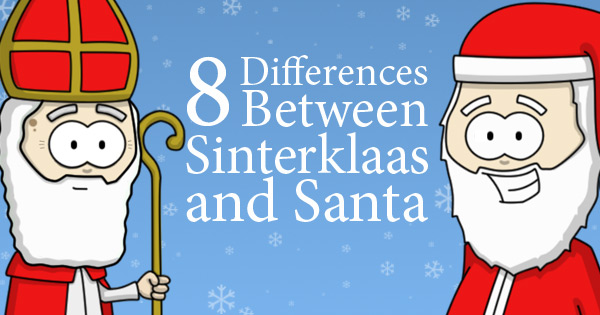
November and December can be a very confusing time of year for expats in The Netherlands, especially for those who have never heard the name Sinterklaas or seen a Zwarte Piet before.
Who is Sinterklaas?
If you were to ask a Dutch Person to describe Sinterklaas they would probably say something along the lines of, “He is a very nice old man who has a long white beard, dresses in red and gives gifts to all the good girls and boys in December.”
Sinterklaas vs Santa
Whatever you do, do not follow this up by asking them how that makes him any different from Santa, not unless you want to seriously damage diplomatic relations between The Netherlands and your own country. They are two very different people. They just happen to work in the same area of business. Here are eight differences that will help you tell them apart.
1) North Pole vs. Spain
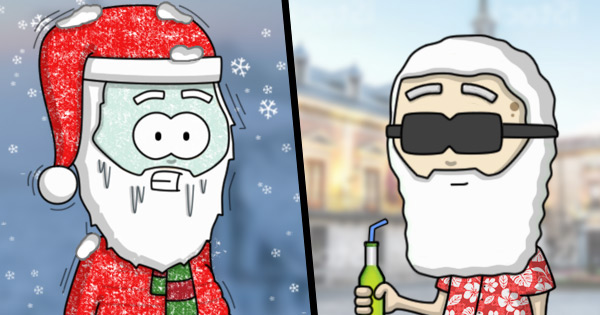
Santa: Lives in freezing cold climate of the North Pole. On Christmas Eve he departs this inhospitable environment, alone, to deliver gifts all around the world without being seen.
Sinterklaas: Lives in Spain for most of the year and (as a result) gets to enjoy more sun and less hypothermia. In the middle of November he temporarily moves his base of operations to the Netherlands to make things easier. His arrival in the country is a huge event known as the Sinterklaas Intocht. A different Dutch city hosts the intocht each year. It is even televised.
2) Fat vs. Thin

Santa: Has not yet found a diet that works for him and as a result tends to be on the overweight side. His weight should not be a surprise. Millions of children all over the world leave cookies, mince pies, milk and/or wine out for him each year.
Sinterklaas: Manages to remain in good shape for his age.
3) Late December vs. Early December
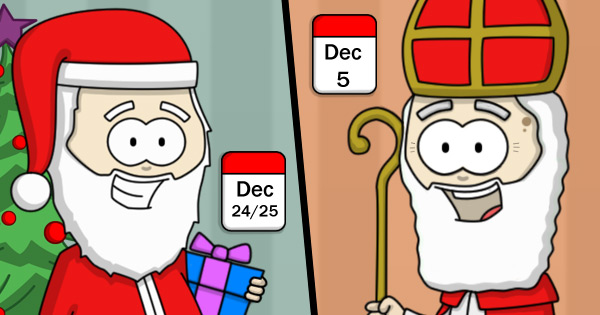
Santa: Delivers gifts under the cover of night on Christmas Eve (December 24th) for children to open the next day on Christmas morning. He has to do this for the whole world in just a few hours.
Sinterklaas: Travels around the Netherlands, delivering gifts, on the 5th of December. The evening this happens is known as Pakjesavond (gift evening). It’s also his birthday. The following day he repeats the process in Belgium and then returns home (to Spain) to enjoy a quiet Christmas.
4) Flying vs. Sailing

Santa: Flies around the world in a sleigh pulled through the night sky by nine magical reindeer.
Sinterklaas: Sails from Spain to The Netherlands in the middle of November on his steamboat, ‘Pakjesboot 12’.
Additional Note: It’s unclear if the preference for flying vs. sailing is because Santa is afraid of sailing or Sinterklaas is afraid of flying. Maybe it has something to do with whatever happened to Pakjesboot 1 to 11.
5) Twelve Reindeer vs. One Horse
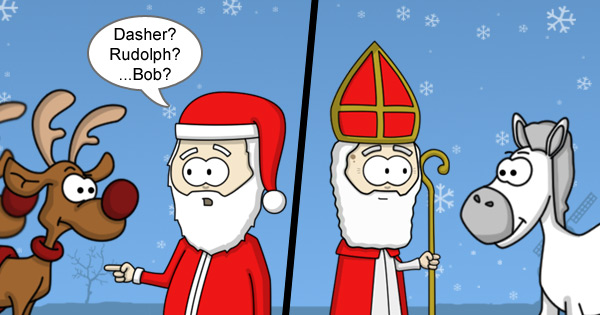
Santa: Has nine overworked magical reindeer who can fly. One of them has a nose that glows.
Sinterklaas: Once he has arrived in the Netherlands he travels around the country on a white horse called Amerigo. As a result, he saves money on animal feed and has to remember less names.
6) List vs. Book
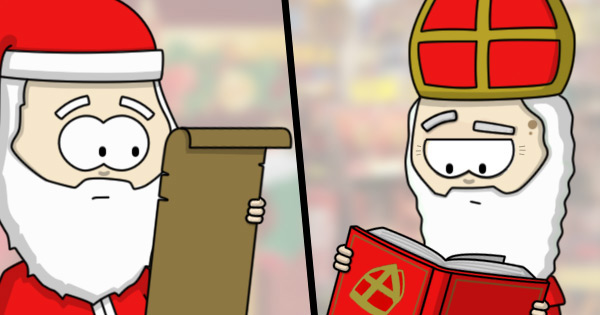
Santa: Keeps the names of the girls and boys who have been naughty or nice on a list (which must be several thousand miles long by now). He used to deal with naughty children by putting a lump of coal in their stocking. However, he has stopped doing that in an attempt to lower his carbon footprint.
Sinterklaas: Keeps everything organized in a book (which never seems to get any bigger despite the growing population). His approach to child behaviour used to be much more zero tolerance. It involved throwing naughty children into a sack, beating them with twigs and dragging them back to Spain. Luckily he realized this was a bit extreme and now takes a much more positive reinforcement approach.
7) Tree vs. Shoe
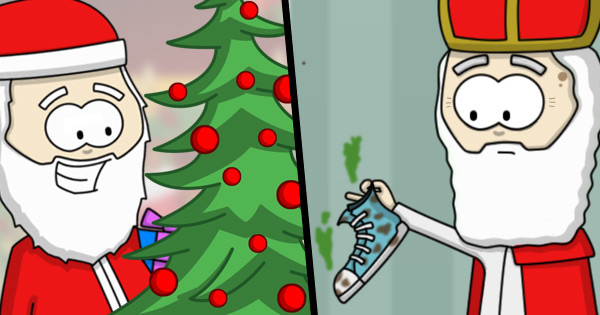
Santa: Places presents for children under the Christmas tree and/or in their stockings on Christmas Eve. This is done secretly and without him being detected.
Sinterklaas: Along with his helpers he already starts delivering gifts before Pakjesavond. They silently leave festive treats, chocolate letters and the occasional small gift known as a schoencadeautje (shoe gift) in children’s shoes. There is often a scattering of Kruidnoten around the scene.
When Pakjesavond arrives they don’t sneak around anymore. They bang on the front door as loudly as they can to announce their arrival. However, when the children open the door Sinterklaas and his helpers are already gone. Only the sack of delivered cadeautjes (gifts) remains.
8) Helpers
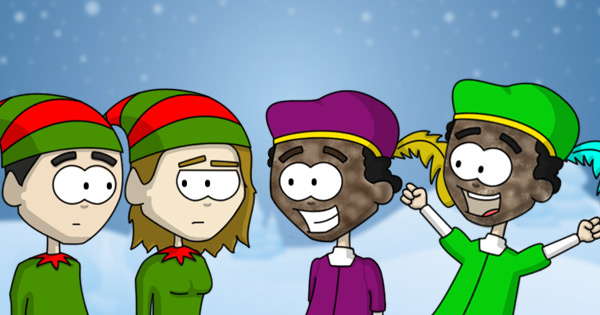
Santa: Helps keep fairytale creature unemployment rates down by employing thousands of elves as his helpers. They run his workshop in the North Pole, help keep him organized and get everything ready for his departure on Christmas Eve. However, they rarely get to leave the North Pole or take part in the deliveries themselves.
Sinterklaas: Has a large group of helpers known as Zwarte Pieten. They are incredibly hyper, a little accident-prone and regularly get their shoe polish mixed up with their face cream. Despite their chaotic nature they get to take on a more active role in the festivities than their elf counter-parts. They crew the steamboat, collect the children’s wish lists, deliver most of the gifts and more.
Conclusion – Sinterklaas vs Santa
Santa: Lives in a freezing cold part of the world. Tries to do all the deliveries, by himself, within just a few hours. Struggles to remain unseen in a growing world of surveillance. Is probably quite stressed.
Sinterklaas: Lives in a warm country. Keeps his home life (Spain) and work-life (the Netherlands/Belgium) separate. Has fun with the public attention. Splits his deliveries over two days and delegates most tasks to his helpers. Has a better life/work balance and is probably less stressed as a result.
Bonus Fact – The Truth About Sinterklaas vs Santa
So there you have it, proof that the two jolly gift-givers are two very different people… or are they?
In 1625 the Dutch travelled to the newly discovered continent of America. Once there they founded the small colonial town of New Amsterdam (which would later become known as New York City). Over time a lot of the traditions of the original Dutch founders were forgotten. However, during the American War of Independence, when the Americans wanted to highlight their non-English past, the Dutch tradition of Sinterklaas was brought back and celebrated once more. Some things were changed of course. It’s even suggested that a miss translation or two led to the Sinterklaas’ new name … Santa Claus.
More Info
Want to read more posts about this Dutch tradition? Check out my post on Why I Love Sinterklaas or read about How to Send a Letter to Sinterklaas.



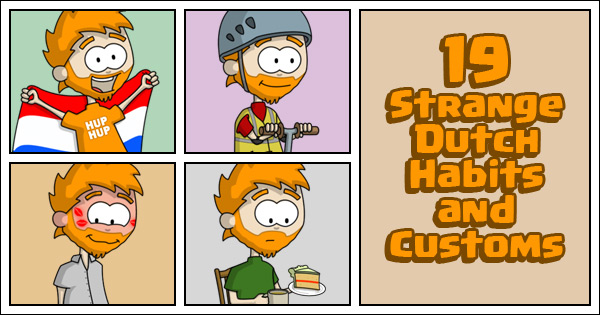

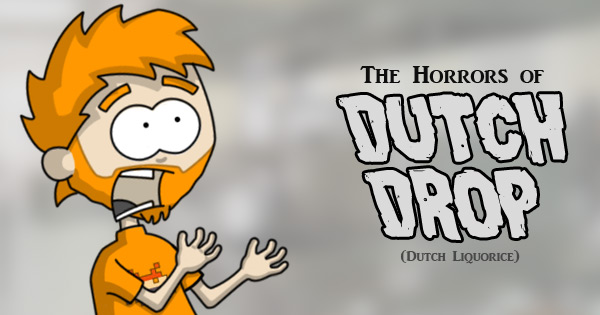



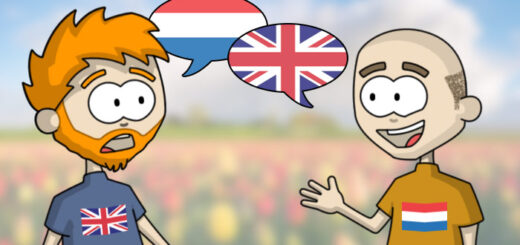

All perfectly true of course, Stu. I shall have to remember this!
I believe it is David Sudakis who tells about Sinterklaas from an American perspective.
If I am not mistaken, it is called ‘3 to 5 black men’.
It starts off with something like ‘legally blind people can go hunting in some of the northern states…’
Actually it should be David Sedaris reads 6 To 8 Black Men – YouTube
Thankyou for this information, I’m a Brit now living in the Netherlands and I never could understand the difference between the two, would like to know more about Sinterklass though, is he a king of some kind??
Hi Gemma. Sinterklaas is a Dutch warping of the mythology/life history of the bishop Saint Nicolas who presided over the church and parishioners in Turkey, Myra.
see https://en.wikipedia.org/wiki/Saint_Nicholas .
Gift giving, and children coming into play from the story that he deftly presented purses of gold coins to three young brides of impoverished background to brighten their wedding. He was notes for many generous acts.
St Nicholas’s feast day, the day of his mortal coil passing is Dec 6. So with varied traditions between European countries/families, children receive presents on the evening of the 5th or morning of the 6th December. Adults exchange (larger) gifts between themselves on Christmas morning.
With the global reach of American marketing, Santa Claus and gift giving traditions have been warped and diluted since the 50’s.
For instance, in France kids look forward to the USA Santa Claus traditions, but calling him Père Noël, father Christmas. No St Nic except in Flemish or Alsace parts of France.
Hi I live in the Netherlands and no he is not a king. Many people think that he is however he is not. Most people on the north side of the Netherlands think that he is a king but in the south side of the Netherlands where I am from he is not so it is mostly where you are from in the Netherlands. Also many people think the St. Nicholas holiday is like Sinterklaas however it is not.
hes just a old guy who gives gifts
good information, but zwarte piet is racist.